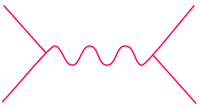Gauge theory
The term gauge refers to any specific mathematical formalism to regulate redundant degrees of freedom in the Lagrangian of a physical system.When they are invariant under a transformation identically performed at every point in the spacetime in which the physical processes occur, they are said to have a global symmetry.Today, gauge theories are useful in condensed matter, nuclear and high energy physics among other subfields.This explained the electromagnetic field effect on the wave function of a charged quantum mechanical particle.Weyl's 1929 paper introduced the modern concept of gauge invariance[3] subsequently popularized by Wolfgang Pauli in his 1941 review.Similarly unnoticed, David Hilbert had derived the Einstein field equations by postulating the invariance of the action under a general coordinate transformation.Inspired by Pauli's descriptions of connection between charge conservation and field theory driven by invariance, Chen Ning Yang sought a field theory for atomic nuclei binding based on conservation of nuclear isospin.[5]: 202 In 1954, Yang and Robert Mills generalized the gauge invariance of electromagnetism, constructing a theory based on the action of the (non-abelian) SU(2) symmetry group on the isospin doublet of protons and neutrons.This led to an increasing interest in gauge theory for its own sake, independent of its successes in fundamental physics.For instance, in Newtonian dynamics, if two configurations are related by a Galilean transformation (an inertial change of reference frame) they represent the same physical situation.As long as this transformation is performed globally (affecting the coordinate basis in the same way at every point), the effect on values that represent the rate of change of some quantity along some path in space and time as it passes through point P is the same as the effect on values that are truly local to P. In order to adequately describe physical situations in more complex theories, it is often necessary to introduce a "coordinate basis" for some of the objects of the theory that do not have this simple relationship to the coordinates used to label points in space and time.The simplest such group is U(1), which appears in the modern formulation of quantum electrodynamics (QED) via its use of complex numbers.In addition to its interaction with other objects via the covariant derivative, the gauge field typically contributes energy in the form of a "self-energy" term.Gauge theories used to model the results of physical experiments engage in: We cannot express the mathematical descriptions of the "setup information" and the "possible measurement outcomes", or the "boundary conditions" of the experiment, without reference to a particular coordinate system, including a choice of gauge.The techniques of calculation in a continuum theory implicitly assume that: Determination of the likelihood of possible measurement outcomes proceed by: These assumptions have enough validity across a wide range of energy scales and experimental conditions to allow these theories to make accurate predictions about almost all of the phenomena encountered in daily life: light, heat, and electricity, eclipses, spaceflight, etc.They fail only at the smallest and largest scales due to omissions in the theories themselves, and when the mathematical techniques themselves break down, most notably in the case of turbulence and other chaotic phenomena.However, continuum and quantum theories differ significantly in how they handle the excess degrees of freedom represented by gauge transformations.More sophisticated quantum field theories, in particular those that involve a non-abelian gauge group, break the gauge symmetry within the techniques of perturbation theory by introducing additional fields (the Faddeev–Popov ghosts) and counterterms motivated by anomaly cancellation, in an approach known as BRST quantization.[citation needed] The mathematical techniques that have been developed in order to make gauge theories tractable have found many other applications, from solid-state physics and crystallography to low-dimensional topology.The following illustrates how local gauge invariance can be "motivated" heuristically starting from global symmetry properties, and how it leads to an interaction between originally non-interacting fields.It is now transparent that the Lagrangian is invariant under the transformation whenever G is a constant matrix belonging to the n-by-n orthogonal group O(n).Now, demanding that this Lagrangian should have local O(n)-invariance requires that the G matrices (which were earlier constant) should be allowed to become functions of the spacetime coordinates x.Invariance of this term under gauge transformations is a particular case of a priori classical (geometrical) symmetry.[12] The complete Lagrangian for the gauge theory is now As a simple application of the formalism developed in the previous sections, consider the case of electrodynamics, with only the electron field.An appropriate covariant derivative is then Identifying the "charge" e (not to be confused with the mathematical constant e in the symmetry description) with the usual electric charge (this is the origin of the usage of the term in gauge theories), and the gauge field A(x) with the four-vector potential of the electromagnetic field results in an interaction Lagrangian whereInfinitesimal gauge transformations form a Lie algebra, which is characterized by a smooth Lie-algebra-valued scalar, ε.A quantity which is gauge-invariant (i.e., invariant under gauge transformations) is the Wilson loop, which is defined over any closed path, γ, as follows: where χ is the character of a complex representation ρ andHowever, because of the subtleties imposed by the gauge constraints (see section on Mathematical formalism, above) there are many technical problems to be solved which do not arise in other field theories.At the same time, the richer structure of gauge theories allows simplification of some computations: for example Ward identities connect different renormalization constants.The main point to quantization is to be able to compute quantum amplitudes for various processes allowed by the theory.
Introduction to gauge theoryGauge theory (mathematics)Quantum field theoryFeynman diagramHistoryField theoryElectromagnetismWeak forceStrong forceQuantum mechanicsSpecial relativityGeneral relativityYang–Mills theorySymmetriesSymmetry in quantum mechanicsC-symmetryP-symmetryT-symmetryLorentz symmetryPoincaré symmetryGauge symmetryExplicit symmetry breakingSpontaneous symmetry breakingNoether chargeTopological chargeAnomalyBackground field methodBRST quantizationCorrelation functionCrossingEffective actionEffective field theoryExpectation valueLattice field theoryLSZ reduction formulaPartition functionPath Integral FormulationPropagatorQuantizationRegularizationRenormalizationVacuum stateWick's theoremWightman axiomsDirac equationKlein–Gordon equationProca equationsWheeler–DeWitt equationBargmann–Wigner equationsSchwinger-Dyson equationRenormalization group equationStandard ModelQuantum electrodynamicsElectroweak interactionQuantum chromodynamicsHiggs mechanismString theorySupersymmetryTechnicolorTheory of everythingQuantum gravityAndersonAnselmBargmannBecchiBelavinBerezinBjorkenBleuerBogoliubovBrodskyBuchholzCachazoCallanColemanConnesDashenDeWittDoplicherEnglertFaddeevFeynmanFramptonFritzschFröhlichFredenhagenGlashowGell-MannGoldstoneGribovGuralnikHeisenberg't HooftIliopoulosIvanenkoJackiwJona-LasinioJordanKällénKendallKinoshitaKlebanovKontsevichKreimerKuraevLandauLehmannLeutwylerLipatovŁopuszańskiLüdersMaianiMajoranaMaldacenaMatsubaraMigdalMøllerNaimarkNishijimaOppenheimerOsbornOsterwalderParisiPecceiPeskinPlefka